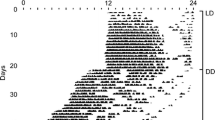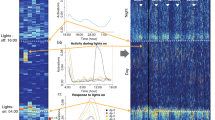Summary
The activity behaviour of the vole, Microtus agrestis, has been recorded in order to investigate the relationship between short-term rhythm and circadian rhythm. A simple device was developed, allowing separate monitoring of the time spent in or outside the nest, wheel-running, eating and drinking. Under natural light conditions during summer, a distinct differentiation between a short term rhythm of eating and drinking during the day-time and a circadian rhythm of wheel-running during the night was observed. The short-term rhythm depends closely on metabolic demands (hunger, thirst, excretion). Control of these demands by an endogenous oscillation could not be substantiated. The circadian rhythm of wheel-running activity is, however, controlled by an endogenous oscillation, synchronized by light conditions. It is subjected to seasonal variations. a) The threshold of light intensity below which wheel-running occurs is lowest during summer (<0.5 lx) and is higher during spring and autum (> 5 lx). b) Wheel-running is controlled by a circadian oscillation during summer only whereas it is an integrated part of the short-term rhythm during spring and autumn (experiments during the winter have not yet been performed). Experiments gave evidence that the properties of the cage can deeply influence the amount and pattern of wheel-running activity. It is concluded that wheel-running reflects a certain level of excitation, which may be caused by different behavioural intentions. The seasonal changes of the control of wheel-running activity are discussed with respect to this assumption. The relevancy of locomotor activity patterns as usually recorded in the laboratory to reveal the physiological and ecological significance of endogenously controlled behavioural patterns is discussed.
Similar content being viewed by others
References
Aschoff, J.: Spontane lokomotorische Aktivität. Handb. Zool. 8 (11), 1–74 (1962)
Aschoff, J.: Human circadian rhythms in activity, body temperature and other functions. Life sciences and space research, pp.159–173. Amsterdam: North-Holland 1967
Aschoff, J., Figala, J., Pöppel, E.: Circadian rhythms of locomotor activity in the golden hamster (Mesocricetus auratus) measured with two different techniques. J. comp. physiol. Psychol. 85, 20–28 (1973)
Brown, L.E.: Field experiments on the activity of the small mammals Apodemus, Clethrionomys and Microtus. Proc. Zool. Soc. London 126, 549–564 (1956)
Crowcroft, P.: The daily cycle of activity in british shrews. Proc. Zool. Soc. London 123, 715–729 (1954)
Erkinaro, E.: The seasonal change of the activity of Microtus aggrestis. Oikos 12, 157–163 (1961)
Erkinaro, E.: Der Phasenwechsel der lokomotorischen Aktivität bei Microtus agrestis (L.), M. arvalis (Pall.) und M. oeconomus (Pall.). Aquilo Ser. Zool. 8, 1–31 (1969)
Erkinaro, E.: Seasonal changes in the phase position of circadian activity rhythms in some voles, and their endogenous component. Aquilo Ser. Zool. 13, 87–91 (1972a)
Erkinaro, E.: Fasväxling hos djur. Fauna och Flora 67, 215–219 (1972b)
Erkinaro, E.: Schubfolgen in der 24-Stundenperiode bei phasenwechselnden Kleinsäugern. Ber. Ökol. Stat. Messaure 23, 27–32 (1973a)
Erkinaro, E.: Short-term rhythm of locomotor activity within the 24 hr period in the Norwegian lemming, Lemmus lemmus, and water vole, Arvicola terrestris. Aquilo Ser. Zool. 14, 46–58 (1973b)
Erkinaro, E.: Activity optimum in Microtus agrestis, Arvicola terrestris and Apodemus flavicollis (Rodentia) dependent on the intensity of illumination. Aquilo Ser. Zool. 14, 89–92 (1973c)
Frank, F.: Beiträge zur Biologie der Feldmaus, Microtus arvalis (Pallas). Teil I: Gehegeversuche. Zool. Jb. (Syst.) 82, 354–404 (1954)
Hatfield, D.M.: Activity and food consumption in Microtus and Peromyscus. J. Mammal. 21, 29–36 (1940)
Kaiser, H., Lehmann, U.: Tidal and spontaneous activity patterns in fiddler crabs. II. Stochastic models and simulations. J. comp. Physiol. 96, 1–26 (1975)
Kavanau, J.L.: Continuous automatic monitoring of the activities of small captive animals. Ecology 44, 95–110 (1963)
Lehmann, U., Neumann, D., Kaiser, H.: Gezeitenrhythmische und spontane Aktivitätsmuster von Winkerkrabben. I. Ein neuer Ansatz zur quantitativen Analyse von Lokomotionsrhythmen. J. comp. Physiol. 91, 187–221 (1974)
Ostermann, K.: Zur Aktivität heimischer Muriden und Gliriden. Zool. Jb. (Physiol.) 66, 355–388 (1956)
Pearson, O.P.: Habits of Microtus californicus revealed by automatic photographic recorders. Ecol. Monogr. 30, 231–249 (1960)
Pohl, H.: Wirkung der Temperatur auf die mit Licht synchronisierte Aktivitätsperiodik bei Warmblütern. Z. vergl. Physiol. 58, 381–394 (1968)
Shillito, E.E.: Exploratory behaviour in the short-tailed vole Microtus agrestis. Behaviour 21, 145–154 (1963)
Stebbins, L.L.: Response of circadian rhythms of Clethrionomys mice to a transfer from 60° N to 53° N. Oikos 25, 108–113 (1974)
Stebbins, L.L.: Short activity periods in relation to circadian rhythms in Clethrionomys gapperi. Oikos 26, 32–38 (1975)
Turner, B.N., Iverson, S.L.: The annual cycle of aggression in male Microtus pennsylvanicus, and its relation to population parameters. Ecology 54, 967–981 (1973)
Author information
Authors and Affiliations
Additional information
Supported by the Deutsche Forschungsgemeinschaft
Rights and permissions
About this article
Cite this article
Lehmann, U. Short-term and circadian rhythms in the behaviour of the vole, Microtus agrestis (L.). Oecologia 23, 185–199 (1976). https://doi.org/10.1007/BF00361235
Received:
Issue Date:
DOI: https://doi.org/10.1007/BF00361235




